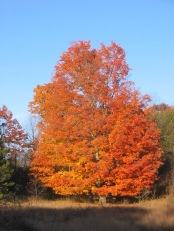You are currently browsing the tag archive for the ‘soil pH’ tag.
Some gardeners insist on the necessity to improve their garden soil. They till in organic matter, peat moss, vermiculite, add sand to clay soils, lime and fertilize trying to achieve perfect soil for gardening. While this works very well, it is just that, work, and often very expensive. There is another argument that claims disturbing the soil causes more harm than good; these gardeners promote growing plants that naturally grow in the soil type found in their yard. It is certainly less work, and if the plants are adapted to your soil, they grow very nicely. Both are right. The argument is not about soil at all, but about the gardener, time, effort, and cost.
My soil is sand deposited by melting glaciers eons ago. It has fast drainage, so can go dry very fast. I have also gardened on very deep silt soil called Loess or the dusty silt blown off glaciers. It’s similar to clay in that it compacts and makes for poor drainage.
The soil topic comprises entire books, including the geology and science behind the types and how to handle them. However, there are one common sense tip for ordinary gardeners: know the soil type and the pH of the garden bed. A soil test will tell the soil’s composition, its pH, and the amount of NPK (Nitrogen, Phosphorus, Potassium–the components of fertilizer) needed for optimum plant growth.
Soil pH is important to know, indicating if the soil is acid or alkaline. pH 7 is neutral, anything below acid, anything above alkaline. Most low rain fall area soils are alkaline as various mineral salts accumulate and are are not washed by frequent rain, most soils in rainy areas are acidic as the various mineral salts are dissolved and washed away. So what? Some Plants have soil pH preferences, others don’t care. Some plants like blueberries want very acid soil, others like lavender prefer alkaline soils. Very acidic or alkaline soils limit the plants that grow in them. In many cases plant preferences depend on the plant’s original global location.
Other than that, there are very few soils that grow nothing, and few perfect soils that grow everything. The base of good soil or garden loam combines clay, sand, and silt, the three basic sizes of mineral content in a soil. Clay is the smallest and compacts easily into, well, clay bricks, but has greater surface area for holding necessary minerals. Sand is the largest and drains fast, but holds less fertility. Silt is somewhere between the two, created by water sedimentation. It has characteristics of both, and the problems of both. Clay soils hold nutrients and water, but they are slow to dry out, and once dry may crack into rock-hard plates on the soil’s surface. Sand soils hold little moisture or nutrients.
It is also important to know that the mineral content makes up only part of a soil’s content. Fifty to fifty-five percent of soil consists of air, water, decaying plant materials (humus), insects, worms, bacteria, fungi and other living organisms. Plant roots use the air, water, and humus for plant growth as well as the minerals found in the soil. Their pH preference helps them absorb these substances. All the living organisms within the soil help decay plant material and often act in symbiosis with the plant’s roots. I’ve read where there is more life below the soil’s surface than there is living on its surface.
Even if you have amended your soil, you need to know its basic type and how to work it. Three rules of thumb:
1. Never work in a wet clay soil, and don’t walk on a wet lawn growing in clay soil. You drive the air spaces out of the soil. Once compacted, reintegrating air space into clay soils is difficult.
2. Sandy soils need additional water and fertilizer applications.
3. In cases of extremely sandy or clay soils, garden in raised beds formed by mounding good loam on top of the native soil.
If you don’t have inclination for the work involved in soil improvement, grow plants for the soil you have.
Clay soil? Grow Aconitum (delphinium), Anemone, Aruncus (goats beard), Asters, Buxus (boxwood), Camassia, Digitalis (foxglove), Forsythia, Helenium, Hemerocallis (daylily), Ilex (holly), Leucojum (snowflake), Mondarda (bee balm), Myosotis (for-get-me-not), Narcissus, Paeonia, Rudbeckia (coneflowers), Solidago (goldenrod), and Viburnum.
Acid soil? Grow Achillea, Allyssum (gold dust), Artemisia, Echinacea, Eryngium, Gaillardia, Helianthemum, Iberis (candytuft), Lavandula, Lilium, Oenothera (evening primrose), Salvia, Sedum, Sempervivum (houseleek). Look up the plants preferences before you purchase them. If you don’t, invest in one for a trial growing period. If it thrives, grow more.
A good garden book will give you more plants for each type of soil. If a plant requires good drainage it will do well in sand. If it requires rich soil, it might grow better in clay or loam soils. Good drainage and rich soil usually means soils leaning towards sandy with high humus amounts.


































